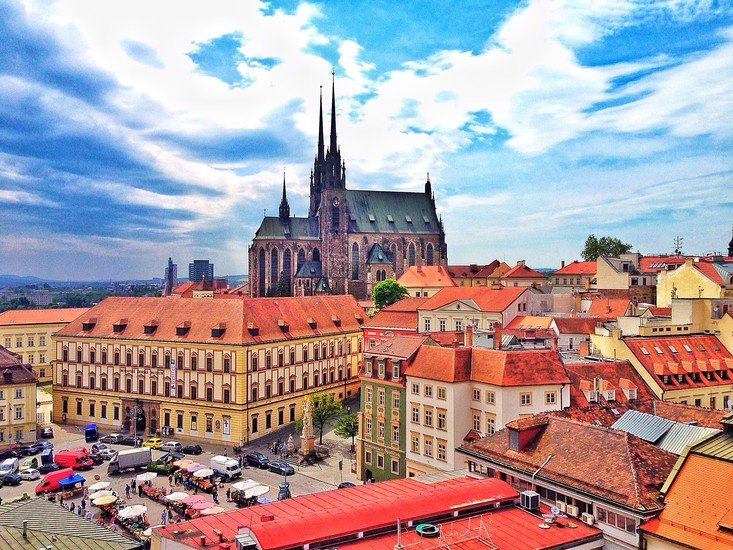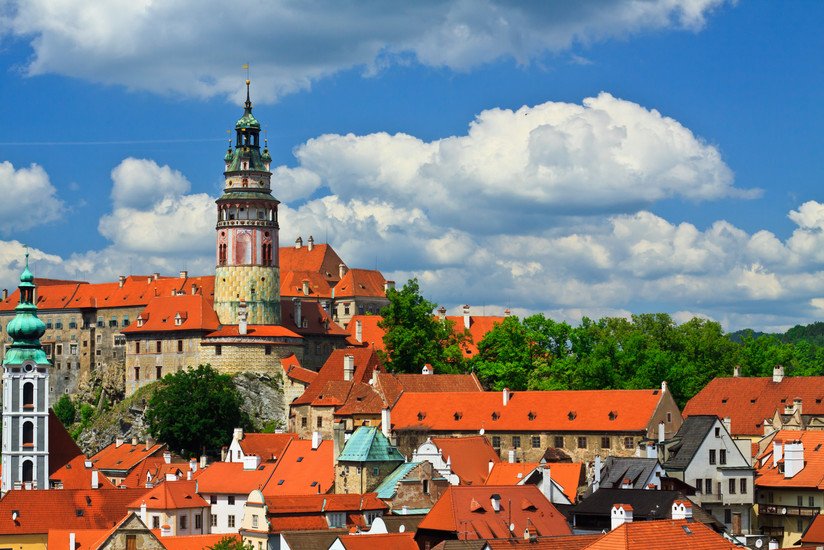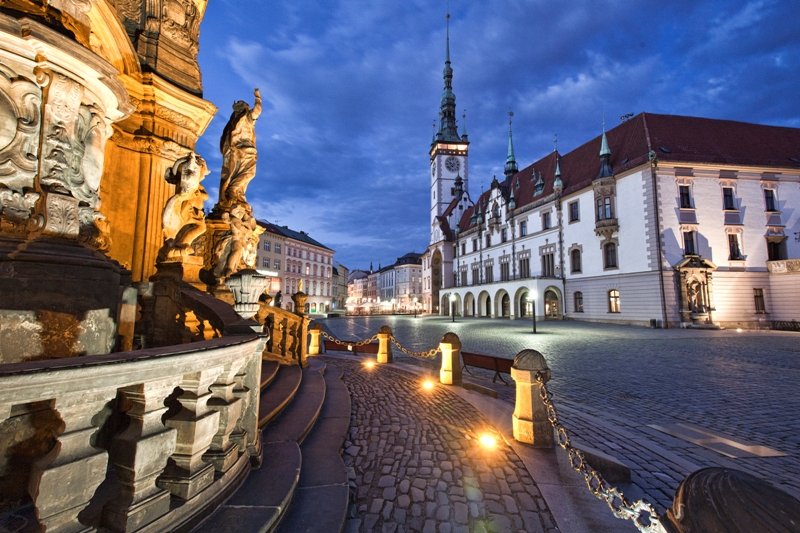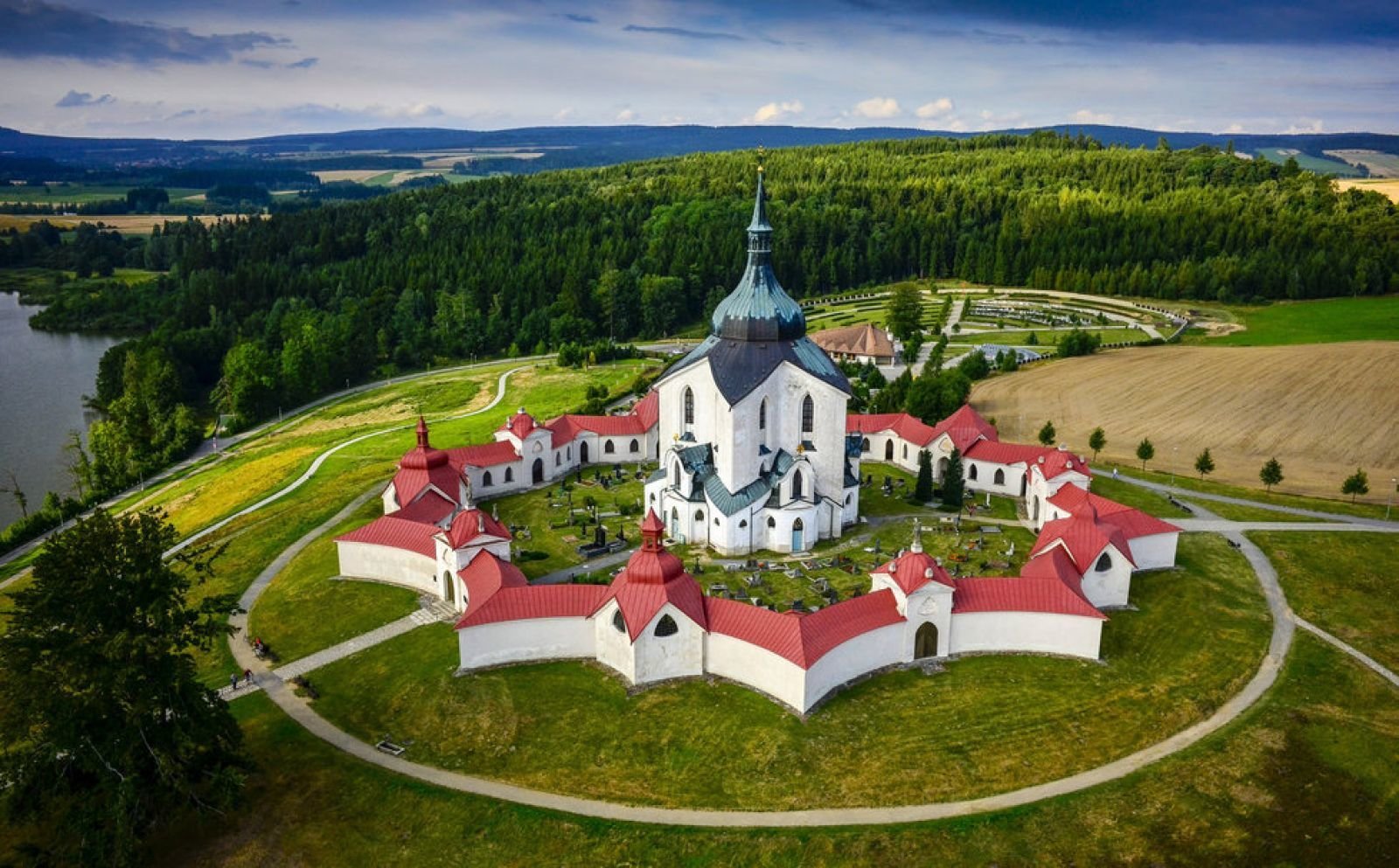By attributing the UNESCO symbol to a site, the entire world community is announcing: "Yes, this is something that is exceptional and unique in the world; it's something that we undertake to protect for each other and in the interest of us all - the nations of the world."
In 1991 Czechoslovakia ratified the Convention Concerning the Protection of the World Cultural and Natural Heritage and since then a total of twelve sites in the Czech Republic have been inscribed in the World Heritage List. We can therefore proudly announce the Czech Republic to be a "UNESCO superpower". We should add that UNESCO is the abbreviation of United Nations Educational, Scientific and Cultural Organization.
Brno

Brno is an important urban monument reservation and the second largest city in the Czech Republic. There has been continuous settlement here since the arrival of the Slavs in the 6th century, through the period of the Great Moravian Empire, and to the present day. Since the end of the 13th century the city has been protected by the Špilberk Castle, which over time became the seat of the Moravian Margraves from the Luxembourg family and the Moravian regional capital.
As with other cities, Brno has hidden secrets, for example the underground catacombs. For tourists from all over the world the greatest attraction is the Tugendhat Villa, which is the architect Ludwig Mies van der Rohe's most important European work, which was inscribed in the UNESCO List in 2001.
Holašovice
The village was first mentioned in the mid-13th century during the period of the colonising movements in the South Bohemian border region. The town has experienced two crippling blows over the years. The first was in the 16th century, when almost all of the original Czech inhabitants of the village were wiped out through plague, following which it was almost immediately occupied by German settlers.The Second World War dealt another blow when the attempts made by the German inhabitants to join the village to the Reich were successful. After the war, in 1946, the enforced withdrawal began which affected the majority of the German inhabitants. The empty buildings were then inhabited by Czechs from the inland, who built very little here, with just some repairs and maintenance being carried out. This meant that in 1998 the almost entirely preserved medieval system of houses and grain stores was inscribed in the UNESCO World Cultural Heritage List.
Český Krumlov

In the southernmost part of the Czech Republic there is a region which is an ideal place to experience some highly interesting adventures. Its centre is the town of Český Krumlov which, although not large in size, is all the more attractive due to its bewitching atmosphere that harks back to ancient times. Thanks to its unique medieval buildings it has been rightly protected by UNESCO since 1992.
As a natural centre it is vibrant not only with history, as over time it has become a city of culture, art and remarkable experiences, and offers up tidbits from its varied menu of cultural events, ranging from visits to museums and galleries to concerts at any of the seven musical festivals or performances laid on as part of the traditional celebrations or special night tours, to events held in the stylish inns. Surrounded by unspoiled natural beauty it attracts all those who want to have an unforgettable, unusual and fascinating time.
Kroměříž
Kroměříž was established as a market town at the crossroads of trading routes. At the time of the church colonisation in the first half of the 12th century it became the property of the Bishops of Olomouc. The village was elevated to town status in the second half of the 13th century, but the religious wars of the 14th century inflicted terrible wounds on the town.The year 1848 was a milestone in the town’s history, when the Constituent Assembly of the Austrian Monarchy was transferred here, and a period of progress began which elevated the town to the highest levels of spiritual culture and art. It is not only interesting for its history and architecture, but also the surrounding nature, which offers visitors a large number of free-time options.
Each year the city plays host to a number of music festivals, exhibitions, conferences and congresses, and the gardens and château were inscribed in the UNESCO World Cultural and Heritage List in 1998.
Kutná Hora

Kutná Hora is, as its name suggests, associated with the mining (kutání in Czech) of silver. In 1142 the first Cistercian monastery in the Czech lands was established in the nearby village of Sedlec and at the end of the 13th century the original mining settlement of Cuthna antiqua – Old Kutna - soon became a wealthy royal city.
In 1300 King Václav II issued the mining legislation „Ius regale montanorum“ and in the same year he initiated a coinage reform. One century later another king, Václav IV, issued the Kutná Hora Decree, which amended the proportion of votes at Prague University in favour of the Czechs. Kutná Hora is therefore rightly considered to be the treasure-house of the land whose wealth gave strength to the expansion of the Kingdom of Bohemia.
Its history and uniqueness were recognised in 1995 when the city was inscribed in the UNESCO World Cultural and Heritage List.
The Lednice-Valtice
The Lednice-Valtice Cultural Landscape is spread over the site of a mighty 12th century border castle. Today it is the home of a romantic château, a picturesque village and in particular a jewel of landscape architecture of unprecedented proportions.The notional milestone at the beginning of the long period of development of this whole area is the end of the 14th century, when the Liechtenstein family obtained a share of the land. The current area, measuring almost 300 km2, is the result of landscaping based on English parks, and thanks to this baroque architecture meets the neo-gothic château and small follies in the romantic style. The Ledice-Valtice Cultural Landscape, as one of the treasures of UNESCO's World Cultural Heritage, was inscribed in its list in 1996.
Olomouc

Olomouc lies at the heart of the Haná region, and is and always has been one of the most important cities in Moravia, where history has gone hand-in-hand with its people, science and progress.
The construction of plague columns in Christian countries was instigated by the Trident Council, and at the time of its construction from 1716-1754 the Olomouc monument was one of the last examples of this fashion wave, but in its creative concept, wealth of decoration and finally its dimensions and height it differs considerably from all similar monuments.
The consecration of the 35 metre-high column on 9th September 1754 was attended in person by the then first couple of the Monarchy, Empress Maria Teresa and her husband Francis I, Holy Roman Emperor, Duke of Lorraine. The Holy Trinity Column was inscribed in the UNESCO list in 2000.
Litomyšl
Litomyšl was established around the trade route that connected Bohemia and Moravia at the end of the 10th and beginning of the 11th centuries. The dominant feature of the city is the Italianate Renaissance castle with its more than eight thousand examples of sgrafitto, which has been on the UNESCO World Cultural and Heritage List since 1999.Litomyšl is the birthplace of the composer Bedřich Smetana, whose name is commemorated by an annual opera festival. On the 500 metre long square can be found the Gothic town hall and a number of Renaissance and Baroque houses. A walk through the historical streets ending in the monastery gardens is an unforgettable experience.
Another interesting sight is the Portmoneum museum with its murals by Josef Váchal. Litomyšl is not only historical, however, for there is a number of modern buildings here and it is proud of the moniker Europe's Blooming City; it is becoming a city of corporate tourism.
Prague

The settlement of Prague and its surroundings was continuous from the early Palaeolithic until the Latenian period. With the arrival of the Celts, oppida began to appear, which were centres of settlement, administration, cults, manufacture, trade and also served as fortified strongholds. There is a school of thought that states that it was the Celtic Boj tribe that provided the basis for the name Bohemia. In the second half of the sixth century the first Slavonic tribes arrived.
In the ninth century the ruling Přemyslid dynasty moved their family seat, thereby laying the foundation stone to this place with the role of the seat of the princely and later the Royal Czech lands. Prague is an important urban monument reservation.
The historic core, 866 hectares in size, encompasses the unique city ensemble of the Prague Castle and Hradčany, Malá Strana (Lesser Side) including Karlův most (Charles Bridge), Staré Město (Old Town) with Josefov (the preserved section of the former Jewish Town), Nové Město (New Town), Vyšehrad and each of the monuments within these areas. It was inscribed in the UNESCO List in 1992.
Telč
Telč is situated at the south-west tip of Moravia, half-way between Prague and Vienna. According to legend the foundation of the city is associated with the victory of the Moravian Prince Otto II over the Bohemian King Břetislav in 1099. It was this victory that meant the building of a chapel, later to become a church, and a settlement which forms today’s Staré Město (Old Town).The city saw its greatest period of expansion under the rule of Zacharias of Hradec in the 2nd half of the 16th century. At the beginning of the 19th century Telč played an important role in the entire south-west region of Moravia, which was still growing with the arrival of the railway.
Because the historical centre of the city, surrounded by fish ponds and city gates, has retained its unique shape over the centuries, in 1992 it was inscribed in the UNESCO List, which brought with it increased interest and a subsequent influx of tourists from around the world.
Třebíč
Třebíč dates from 1101 when a Benedictine monastery was established here. Thanks to its position on the banks of the River Jihlava and the munificence of its founders the city became an important centre for religious life and education. Today it is an important economic, administrative, political and cultural centre in south-west Moravia.The city offers a wide range of active recreation opportunities in the picturesque environment of the foothills of the Czech-Moravian Vysočina (Highland) region. The city was once a centre of Jewish culture in Moravia and the uniquely preserved Jewish Quarter bears silent witness to the cohabitation between Jews and Christians in this city.
When we take our tour we will go to the Jewish quarter and the Basilica of St. Prokop, which were inscribed in the UNESCO list in 2003.
Žďár nad Sázavou
![]()
Žďár nad Sázavou is a pleasant little market town in the heart of the country, one that ticks all the boxes you expect from pleasant little market towns in Czechia. All eyes venture to the very edge of the town though, where a quite staggering piece of religious architecture is found in the shape of the Pilgrimage Church of St John of Nepomuk. Well, the shape is that of a star, to be exact. The church was built in the 1820s and is arguably the most recognisable work of Jan Blažej Santini Aichel, the Prague-born architect who combined the Baroque and the Gothic with style.The best way to view the church and its surrounding cloisters is from above, although we’re going to go ahead and presume that the number of birds reading this is zero. The church is dedicated to St John of Nepomuk, the tight-lipped 14th century man who refused to divulge the secrets of the confessional and was drowned in the Vltava for his troubles. His tongue was declared incorruptible by the Roman Catholic Church, and the this pilgrimage spot was constructed in his honour.





Comments